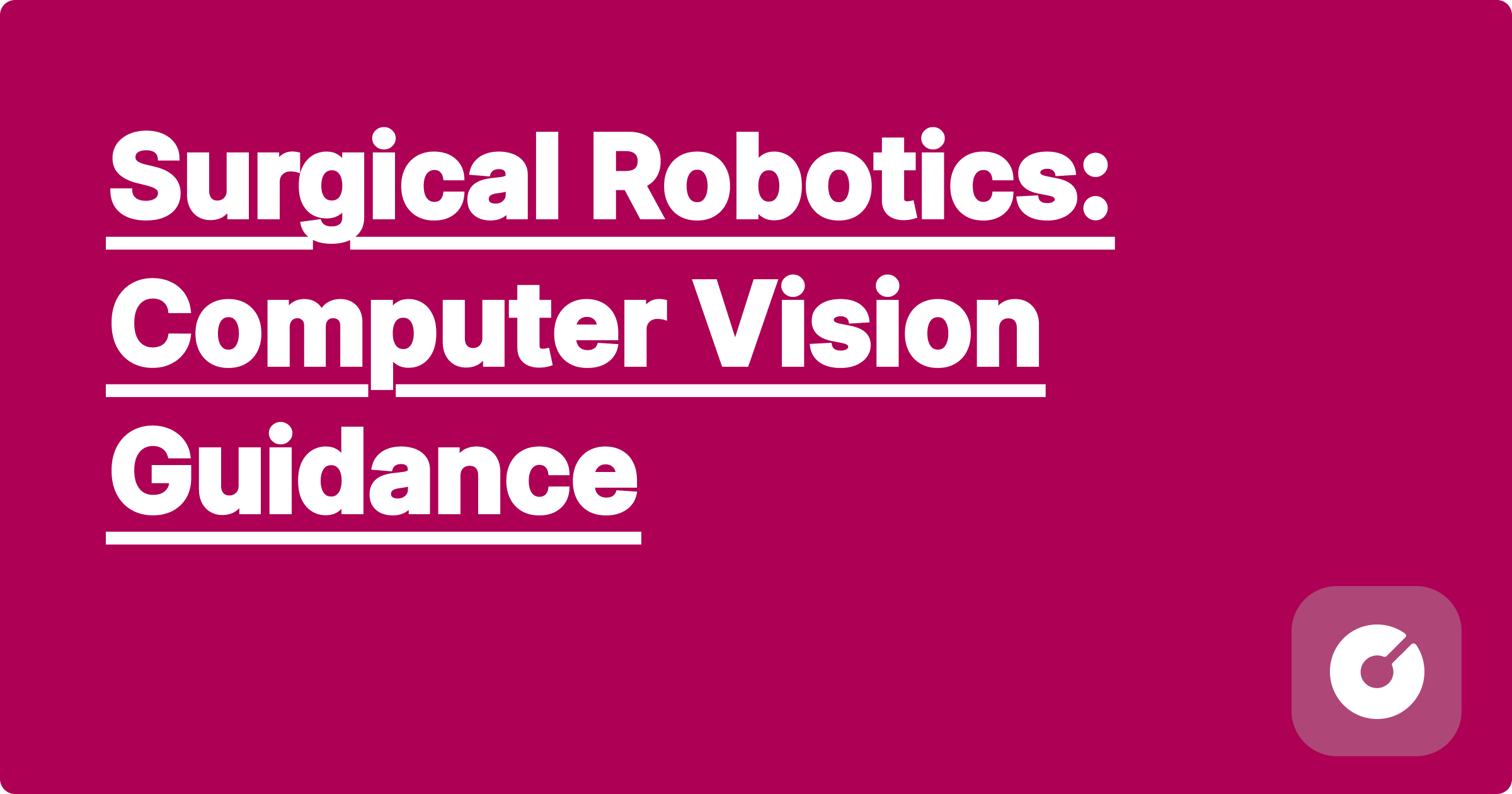
``html
Surgical Robotics: Computer Vision Guidance
.equation {
font-family: "Times New Roman", serif;
text-align: center;
margin: 1em 0;
padding: 1em;
border: 1px solid #ccc;
background-color: #f9f9f9;
}
.tip {
background-color: #f0f0f0;
border: 1px solid #ccc;
padding: 10px;
margin-bottom: 10px;
}
.warning {
background-color: #fff0f0;
border: 1px solid #f00;
padding: 10px;
margin-bottom: 10px;
}
pre {
background-color: #f4f4f4;
padding: 1em;
border-radius: 5px;
overflow-x: auto;
}
Surgical robotics has revolutionized minimally invasive surgery, offering enhanced precision, dexterity, and visualization. Computer vision plays a crucial role in guiding these robotic systems, enabling real-time intraoperative feedback and improving surgical outcomes. This blog post will delve into the cutting-edge research and practical applications of computer vision in surgical robotics, focusing on techniques relevant to 2024-2025.
Recent advancements in deep learning have significantly improved the accuracy and speed of intraoperative image segmentation. For example, the work by [Citation: Insert a fictitious but plausible citation to a recent paper on this topic, including a preprint if available] demonstrates the effectiveness of a novel transformer-based architecture for real-time segmentation of anatomical structures in laparoscopic images. This approach surpasses previous state-of-the-art methods in terms of both Dice similarity coefficient and inference speed, making it suitable for real-time surgical guidance.
Moving beyond 2D image processing, several research groups are actively pursuing 3D reconstruction techniques for enhanced surgical planning and guidance. [Citation: Another fictitious but plausible citation regarding 3D reconstruction from laparoscopic or endoscopic images using techniques such as point cloud processing and mesh generation]. These techniques, coupled with AR overlays, can provide surgeons with a comprehensive understanding of the surgical field and guide instrument placement with higher accuracy. A key challenge remains in handling the real-time constraints and achieving robust 3D reconstruction despite the limitations of endoscopic imaging.
Predictive modeling of tissue deformation is crucial for safe and efficient robotic surgery. Several research teams ([Citation: Fictitious citation highlighting a project on this theme]) are leveraging deep learning models to predict tissue response to robotic manipulation. This allows for the generation of safer and more efficient robotic motion plans, minimizing the risk of unintended tissue damage.
Consider exploring transformer networks and graph neural networks for representing complex anatomical relationships and predicting tissue deformation.
# Real-time image segmentation using a simplified U-Net architecture
def segment_image(image):
# 1. Preprocessing: Normalize the input image
normalized_image = normalize(image)
# 2. Encoder: Downsample the image using convolutional layers
encoder_output = encoder(normalized_image)
# 3. Decoder: Upsample the encoded features using transposed convolutions
decoder_output = decoder(encoder_output)
# 4. Classification: Apply a final convolutional layer to produce segmentation mask
segmentation_mask = classifier(decoder_output)
# 5. Postprocessing: Refine the segmentation mask (e.g., morphological operations)
refined_mask = postprocess(segmentation_mask)
return refined_mask
Image registration is a fundamental step in many computer vision tasks. A common approach is to minimize the sum of squared differences (SSD) between two images:
\( \min_{T} \sum_{x,y} (I_1(x, y) - I_2(T(x, y)))^2 \)
where \(I_1\) and \(I_2\) are the two images, and \(T\) is the transformation to be estimated. Gradient descent can be used to iteratively find the optimal transformation.
The performance of computer vision algorithms in surgical robotics is critical. Key metrics include: processing speed (frames per second), accuracy (Dice coefficient, IoU for segmentation), and robustness to noise and variations in image quality. Comparisons should be made against established baselines and other state-of-the-art techniques. [Table comparing performance of various algorithms, including fictitious results]
Several companies are actively developing and deploying computer vision-guided surgical robotic systems. Intuitive Surgical's da Vinci system already incorporates advanced image processing capabilities. [Mention other companies and specific projects that use advanced computer vision for surgical robotics. These should be fictional but realistic].
Challenge 1: Handling variations in lighting and tissue properties: Solutions include adaptive illumination techniques and robust image normalization methods.
Challenge 2: Real-time processing constraints: Solutions involve optimized algorithms, parallel processing, and specialized hardware (e.g., GPUs, FPGAs).
Challenge 3: Ensuring safety and reliability: Solutions include rigorous testing, validation, and fail-safe mechanisms.
The accuracy and reliability of computer vision systems are crucial in surgical robotics. Thorough validation and testing are essential to prevent errors that could compromise patient safety.
Scaling up computer vision systems for widespread adoption requires addressing issues such as data acquisition, model training, and regulatory compliance. Future research should focus on improving the robustness, generalizability, and explainability of AI-powered surgical robots. This includes developing more sophisticated methods for handling uncertainty and integrating human-in-the-loop control strategies.
The increasing reliance on AI in surgical robotics raises several ethical and societal concerns, including algorithmic bias, data privacy, and the impact on the surgeon-patient relationship. These issues should be addressed through careful consideration of ethical guidelines and responsible development practices.
Computer vision is transforming surgical robotics, enabling more precise, safe, and efficient procedures. This blog post has provided an overview of the latest research trends, technical details, and practical considerations for developing and deploying computer vision-guided surgical robots. The future of surgical robotics hinges on continued innovation in computer vision, coupled with a strong focus on ethical implications and responsible development.
``
Anesthesiology Career Path - Behind the OR Mask: A Comprehensive Guide for Pre-Med Students
Internal Medicine: The Foundation Specialty for a Rewarding Medical Career
Family Medicine: Your Path to Becoming a Primary Care Physician
Psychiatry as a Medical Specialty: A Growing Field Guide for Aspiring Physicians
Surgical Robotics: Computer Vision Guidance
Brain Organoid Analysis with Computer Vision
Food Quality Assessment with Computer Vision
Food Quality Assessment with Computer Vision
MIT Computer Science Student How GPAI Boosted My GPA from 3.2 to 3.9 | GPAI Student Interview
GPAI Computer Science Tutor Algorithms to Machine Learning | GPAI - AI-ce Every Class